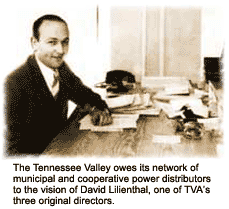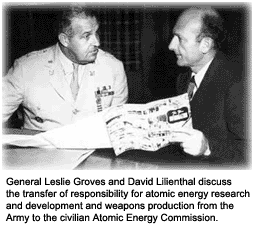David Lilienthal had already developed a reputation as a fighter for the public interest when he became one of the three directors of the newly formed Tennessee Valley Authority (TVA) in 1933. After years of battling with his more conservative colleagues, Lilienthal officially took charge of the TVA in 1941 and directed it through the war years. In 1946, he became the first chairman of the United States Atomic Energy Commission.
David Eli Lilienthal was born on July 8, 1899, into a family of Jewish immigrants from Czechoslovakia, then part of the Austro-Hungarian Empire. His father was a storekeeper and moved the family from Morton, Illinois, where David was born in Indiana, where he grew up and attended public schools. He graduated Phi Beta Kappa from DePauw University, in Greencastle, Indiana, while still 20 years old and received a law degree from Harvard Law School three years later.
 Lilienthal returned to the Midwest to take a job with a Chicago law firm. In 1930, he gained prominence by successfully litigating the Smith v. Illinois Bell Telephone Company telephone rate case before the U.S. Supreme Court. The State of Wisconsin appointed him as public service commissioner, and in that capacity he defended public interests against such corporations as American Telephone & Telegraph, and Wisconsin Power and Light.
In 1933, President Franklin D. Roosevelt asked Lilienthal to become one of the first three directors of the TVA. Lilienthal was more than two decades younger than either Arthur Morgan or Harcourt Morgan, the other two directors. Arthur Morgan, the first chairman, wanted to make deals with private utilities for the distribution of TVA's electrical power. Lilienthal, very skeptical about private utilities through his litigation experiences, wanted TVA to deliver its own power and distribute it through public utility districts.
Tired of the ongoing conflicts between the directors, Roosevelt resolved the situation in Lilienthal's favor by firing Arthur Morgan in 1938. Harcourt Morgan, no relation to Arthur, became the second chairman, but gave Lilienthal considerable latitude. Free to pursue his own agenda, Lilienthal responded by making TVA as competitive with private utilities as possible. When Harcourt Morgan resigned in 1941, he recommended Lilienthal as his successor and Roosevelt concurred.
During World War II, Lilienthal oversaw the construction of 12 power generation facilities, which was seen as the largest engineering and construction project in U.S. history. One of his customers was the Clinton Works at Oak Ridge, Tennessee, which required huge quantities of electrical power to produce the enriched uranium required for the Manhattan Project, producers of the first atomic bomb. He once described the TVA as "the largest producer of power for war in the Western Hemisphere."
Following the end of the war, President Harry S. Truman asked Undersecretary of State Dean Acheson to prepare a plan for the international control of atomic energy. Acheson tapped Lilienthal to provide him with scientific expertise. In early 1946, they announced the Acheson-Lilienthal Report, which recommended that all fissile material be under international control. Their suggestions, later modified by Bernard Baruch, were presented to the United Nations, but Baruch's version was rejected by the Soviet Union because of lenient requirements for atomic weapons reduction for the United States.
Lilienthal returned to the Midwest to take a job with a Chicago law firm. In 1930, he gained prominence by successfully litigating the Smith v. Illinois Bell Telephone Company telephone rate case before the U.S. Supreme Court. The State of Wisconsin appointed him as public service commissioner, and in that capacity he defended public interests against such corporations as American Telephone & Telegraph, and Wisconsin Power and Light.
In 1933, President Franklin D. Roosevelt asked Lilienthal to become one of the first three directors of the TVA. Lilienthal was more than two decades younger than either Arthur Morgan or Harcourt Morgan, the other two directors. Arthur Morgan, the first chairman, wanted to make deals with private utilities for the distribution of TVA's electrical power. Lilienthal, very skeptical about private utilities through his litigation experiences, wanted TVA to deliver its own power and distribute it through public utility districts.
Tired of the ongoing conflicts between the directors, Roosevelt resolved the situation in Lilienthal's favor by firing Arthur Morgan in 1938. Harcourt Morgan, no relation to Arthur, became the second chairman, but gave Lilienthal considerable latitude. Free to pursue his own agenda, Lilienthal responded by making TVA as competitive with private utilities as possible. When Harcourt Morgan resigned in 1941, he recommended Lilienthal as his successor and Roosevelt concurred.
During World War II, Lilienthal oversaw the construction of 12 power generation facilities, which was seen as the largest engineering and construction project in U.S. history. One of his customers was the Clinton Works at Oak Ridge, Tennessee, which required huge quantities of electrical power to produce the enriched uranium required for the Manhattan Project, producers of the first atomic bomb. He once described the TVA as "the largest producer of power for war in the Western Hemisphere."
Following the end of the war, President Harry S. Truman asked Undersecretary of State Dean Acheson to prepare a plan for the international control of atomic energy. Acheson tapped Lilienthal to provide him with scientific expertise. In early 1946, they announced the Acheson-Lilienthal Report, which recommended that all fissile material be under international control. Their suggestions, later modified by Bernard Baruch, were presented to the United Nations, but Baruch's version was rejected by the Soviet Union because of lenient requirements for atomic weapons reduction for the United States.
 When the U.S. Atomic Energy Commission was created to take over the work of the Manhattan Project later in 1946, Lilienthal became its first chairman. Along with J. Robert Oppenheimer, he opposed the crash program to develop the Hydrogen Bomb. He recommended instead that the United States concentrate on building its stockpile of less destructive atomic weapons, but he was overruled by Eisenhower who felt it was in the country’s best interest to pursue the crash program.
In 1950, Lilienthal left the AEC in protest to Eisenhower’s decision and entered private business. He founded Development and Resource Corporation in 1955, which assisted the underdeveloped countries of Colombia, Peru, Brazil, Iran, and Vietnam in technical matters relating primarily to public works. He died of a heart attack on January 14, 1981, in New York City.
When the U.S. Atomic Energy Commission was created to take over the work of the Manhattan Project later in 1946, Lilienthal became its first chairman. Along with J. Robert Oppenheimer, he opposed the crash program to develop the Hydrogen Bomb. He recommended instead that the United States concentrate on building its stockpile of less destructive atomic weapons, but he was overruled by Eisenhower who felt it was in the country’s best interest to pursue the crash program.
In 1950, Lilienthal left the AEC in protest to Eisenhower’s decision and entered private business. He founded Development and Resource Corporation in 1955, which assisted the underdeveloped countries of Colombia, Peru, Brazil, Iran, and Vietnam in technical matters relating primarily to public works. He died of a heart attack on January 14, 1981, in New York City.